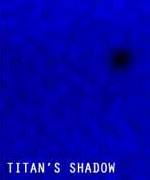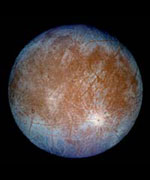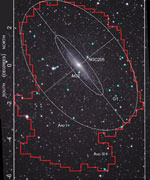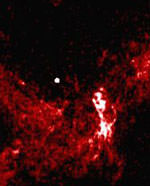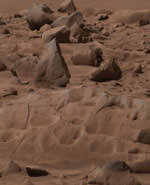
Image credit: UA
The hunt for space rocks on a collision course with Earth has so far been pretty much limited to the Northern Hemisphere.
But last week astronomers took the search for Earth-threatening asteroids to southern skies.
Astronomers using a refurbished telescope at the Australian National University’s Siding Spring Observatory discovered their first two near-Earth asteroids (NEAs) on March 29. NEAs are asteroids that pass near the Earth and may pose a threat of collision.
Siding Spring Survey (SSS) astronomer Gordon Garradd detected a roughly 100-meter (about 300-foot) diameter asteroid and 300-meter (about 1,000-foot) diameter asteroid in images he obtained with the 0.5-meter (20-inch) Uppsala Schmidt telescope.
SSS partner Robert H. McNaught confirmed both discoveries in images he took with the Siding Spring 1-meter (40-inch) that same night.
The 100-meter asteroid, designated 2004 FH29, makes a complete orbit around the sun every 2.13 years. It missed Earth by 3 million kilometers (1.9 million miles), or 8 times the Earth-to-moon distance, yesterday, traveling at 10 km per second (22,000 mph) relative to Earth.
The 300-meter asteroid, designated 2004 FJ29, orbits the sun about every 46 weeks. It came within 20 million kilometers (12 million miles), or within 52 lunar distances of Earth, last Tuesday, March 30, traveling at 18 km per second (40,000 mph) relative to Earth.
Neither object poses a direct threat of colliding with Earth.
Had the asteroids not missed, damage from their impacts would have depended on what kind of rock they’re made of. The 100-meter object likely would mostly burn up in Earth’s atmosphere in an airblast equivalent to 10 megatons of TNT, comparable to the 1908 explosion above the Tunguska River valley in Siberia, McNaught said. The 300-meter rocky asteroid likely would reach Earth’s surface, dumping the equivalent of 1,400 megatons of TNT energy into Earth’s atmosphere, he added. That’s comparable to 200 Tunguskas, or 24 times the largest thermonuclear bomb explosion, a 58 megaton Soviet bomb exploded in 1961.
The new survey is a joint collaboration between the University of Arizona Lunar and Planetary Laboratory and ANU’s Research School of Astronomy and Astrophysics. It is funded by NASA’s Near-Earth Object Observation Program, a 10-year effort to discover and track at least 90 percent of the one kilometer (six-tenths of a mile) or larger NEOs with the potential to become impact hazards.
When astronomers detect what they suspect is an NEA, they immediately must take additional images to confirm their discovery, McNaught said. Surveys often have to suspend their NEA searches and spend observing time confirming NEAs, or they risk losing them altogether because follow-up observations were made too late, he added.
The SSS plan is to use the 1-meter (40-inch) telescope for part of the month to quickly confirm suspect asteroids detected with the Uppsala, freeing the smaller telescope to continue it searches.
“Our confirmation strategy worked beautifully on our first try,” McNaught said.
The Uppsala Schmidt telescope was built in the 1950s for Uppsala Observatory in Sweden. It was sited at Stromlo as the Uppsala Southern Station to make wide field photographs of the southern sky. Increasing light pollution from Canberra led to its relocation to Siding Spring, near Coonabarabran in New South Wales, in 1982. Despite its high quality optics, the telescope drifted into disuse because it used photographic film rather than modern electronic detectors and had to be operated manually.
In 1999, McNaught and Stephen M. Larson of UA?s Lunar and Planetary Laboratory joined in an effort to refurbish and upgrade the Uppsala telescope. Larson had similarly just overhauled a manually operated, photographic wide-field Schmidt telescope in the Santa Catalina Mountains north of Tucson for his Catalina Sky Survey (CSS), part of the NASA-funded program to spot and track asteroids headed toward Earth.
The SSS builds on telescope control, detector technology and software developed for the CSS in Tucson. During the upgrade, the Uppsala was completely reconditioned, and fitted with computer control, a large format (16 megapixel) solid state detector array, and extensive support computers and software that detects objects moving against background stars.
Larson said his reaction to the SSS milestone was “one of relief, since it took several years to make the telescope and facility modifications. Now the real work begins.”
Larson and Catalina Sky Survey team member Ed Beshore worked on commissioning the Uppsala telescope during the past few months. Commissioning a telescope is like commissioning a ship: You have to get all the parts working and working together, and adjust things so they perform as expected.
“We actually achieved ‘first light’ last summer, with good images from the start,” Larson said.
McNaught and Garradd will operate SSS about 20 nights each month. They suspend operations when the week around full moon brightens the sky, making faint object detection difficult.
The Catalina telescope, which Larson and his team upgraded again in May 2000, features new optics that give it a 69 centimeter (27-inch) aperture and a new, more sensitive camera. In addition to Larson and Beshore, Eric Christensen, Rik Hill, David McLean, and Serena Howard operate CSS.
Both CSS and SSS telescopes can detect objects as faint as 20th magnitude, close to sky background level generated by scattered city light and auroral glow that brightens Earth?s upper atmosphere.
Original Source: UA News Release


